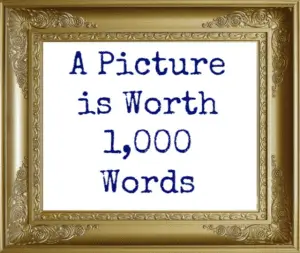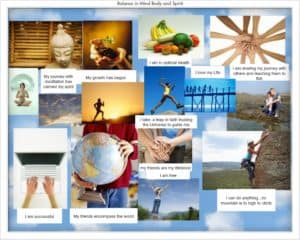Table of Contents

Vision Boards
I like to create vision boards for myself because sometimes pictures say more than words. Or the combination of a picture with a few words is all my brain needs to get the message. But I might be more of a visual learner than some others. Sometimes I find the use of too many words to describe something rather annoying and I might say show me rather than tell me. The main reason I create vision boards is that I want a visual image of my training goals in addition to the written outline of my goals. For me personally, I can recall an image on my board during a hard workout fairly quickly and this can help me stick with it, especially if I am in the middle of feeling some pain!
Pictures can say so many things. Just look at the dog in the picture below!

*This post may contain affiliate links. As an Amazon Associate we earn from qualifying purchases.
Recently we had the opportunity to sit down and record a podcast with Sara Isakovic of Slovenia, a three-time Olympic swimmer who earned a silver medal at the 2008 Olympics in China in the 200m Freestyle, at the age of 20. Remarkably, her first Olympic experience was in Athens in 2004 at the age of 16! What we found most profound about her story is a dream board that she used as a focal point for her goal of winning an Olympic gold medal. She talks about this simple yet powerful visual tool that helped her keep her focus when times were challenging. You can listen to Sara’s story here.
Vision Boards or Training Boards: Controversy
There is some controversy, believe it or not, about the terminology and the use of vision boards or training boards. Vision boards, sometimes also known as dream boards, have been in existence for many, many years. However, some have linked vision boards to the publication of the book, The Secret, which is about the topic of law of attraction and putting time into focusing on what you desire. The intent of this article is not to analyze this book or the premise but more to make clear the purpose and how to use a vision board if you want to include this as part of your goal setting process. This is one reason some prefer the word training board rather than vision board. The idea is to use it as a mental tool rather than just a vision board designed to achieving certain things. The main point with this controversy is you should know HOW you want to use the vision board (the term I prefer) so that the board can serve a purpose.
To see the most popular vision boards just click here.
Four Keys in Creating a Vision Boards For Athletes
 1. INTENTION: The first key involved in creating vision boards is to know your intention or the reason you want to create it. Is it to help you have more clear images as to what you are hoping to do (process goals), or to achieve (outcome goals)? Is it for helping you outline clear steps you will take to reach your goals? Is it a visual of your written goals?
1. INTENTION: The first key involved in creating vision boards is to know your intention or the reason you want to create it. Is it to help you have more clear images as to what you are hoping to do (process goals), or to achieve (outcome goals)? Is it for helping you outline clear steps you will take to reach your goals? Is it a visual of your written goals?
2. REFLECTION: The second key is to take some time to reflect. You can do this with a coach, with teammates or friends, or by yourself. The important part is to take some time to develop clarity about your intention and some of the ideas you want in pictures or words.
3. THE BIG PICTURE: The third key is to think of the board as a part of your overall goal making process. Integrating a vision board into your overall season goals gives it more meaning. We often write goals and understand that goals need to be action oriented. This means our boards should include something about what we will actually be doing to achieve our goals. I personally find looking for pictures and words of my goals really helpful with knowing what I want and why I want to have a certain goal. For these reasons I like to have some images of what I am hoping to achieve but I also really like images of what I need to actually do to get my goal. For example, one of my goals for the year is to be engaged in more strenuous training. I found a picture of a person pushing a boulder up a hill and the words “go the extra mile” and chose to use both of those on my board as a reminder to me to commit to my goal of more intense training.
4. VISUAL: The fourth key is to display the board so you see it. That way it is like a daily review of what I am wanting to do, sort of like a “to do list.”
Visions and Goals Change
Remember to see your vision board as a work in progress. You might realize with time that your goals have to change or new ones might be added. Therefore, your images and words might need to change. Don’t be afraid to alter the board. This is how it stays relevant for you. Above is picture of a vision board. Try it. Have fun finding the images and words and see if it helps you clarify your goals for a season.
